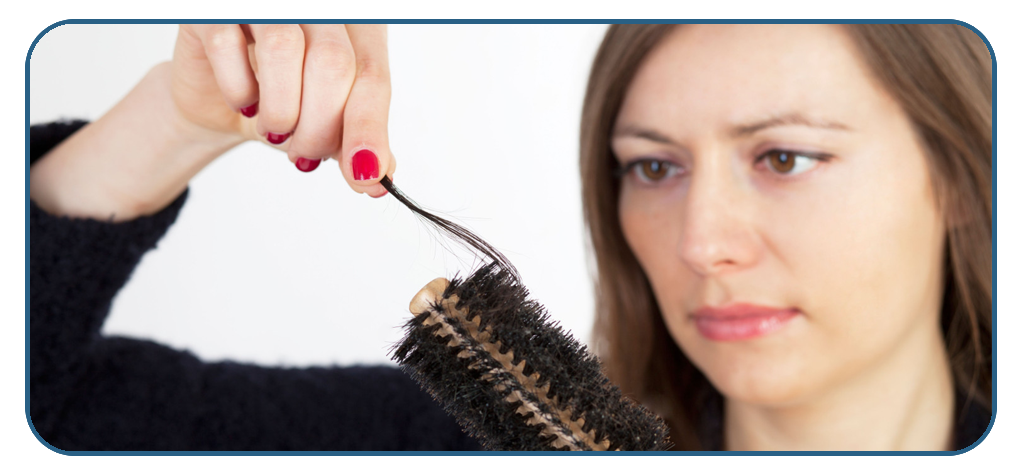Treatment Of
Hair loss in Women
 ALOPECIA IN FEMALES
ALOPECIA IN FEMALES
Hair is a cutaneous appendage typical of mammalian skin.
The normal cycle of hair growth lasts for 2 to 6 years. Hair growth occurs in 3 cycles. About 90 percent of the hair on your scalp is growing at any one time. This growth phase usually lasts for about 2-6 years (anagen). Each hair grows approximately 1 centimeter (less than half an inch) per month during this phase
It is then followed by the transitional phase (catagen) that takes 1-3 weeks. About 10 percent of the hair on your scalp, at any one time, is in a resting phase for 3 months (telogen). After 2 to 3 months, the resting hair falls out and new hair starts to grow in its place.
It is normal to shed some hair each day as part of this cycle (approximately 70-80 hairs/day). However, some people may experience excessive (more than normal) hair loss. Hair loss of this type can affect men, women and children.
Roots of the hairs are deep enough to be affected by hair oils and shampoos ANDROGENETIC ALOPECIA
The majority of women with androgenetic alopecia have diffuse thinning on all areas of the scalp. (Men rarely have diffuse thinning but instead have more distinct patterns of baldness.) Some women have a combination of two pattern types.
Androgenic alopecia in women is due to the action of androgens, male hormones that are typically present in only small amounts.
Androgenic alopecia can be caused by a variety of factors tied to the actions of hormones, including some ovarian cysts, taking high androgen index birth control pills, pregnancy, and menopause.
Just as in men, the hormone DHT appears to be at least partially to blame for the miniaturization of hair follicles in women suffering with female pattern baldness. Heredity plays a major factor in the disease TELOGEN EFFLUVIUM
When your body goes through something traumatic like child birth, malnutrition, a severe infection, major surgery, or extreme stress, it can impact your hair.
Many of the hairs in the growing (anagen) or transitional (catagen) phases can actually shift all at once into the resting (telogen) phase.
About six weeks to three months after the stressful event, the shedding phenomenon called telogen effluvium may begin. It is possible to lose handfuls of hair at a time when in full-blown telogen effluvium.
For most who suffer with this, complete remission is probable as long as severely stressful events can be avoided.
For some women, however, telogen effluvium is a mysterious chronic disorder and can persist for months or even years without any true understanding of the triggering factors. ANAGEN EFFLUVIUM
Anagen effluvium occurs after any insult to the hair follicle that impairs its cellular-level mitotic or metabolic activity.
This hair loss is commonly associated with chemotherapy. Since chemotherapy targets rapidly dividing cancer cells, your skin-on-boddy other rapidly dividing cells -- such as hair follicles in the growing (anagen) phase -- are also greatly affected. Soon after chemotherapy begins, approximately 90% or more of hairs in the anagen phase can fall out.
The characteristic finding in anagen effluvium is the tapered fracture of the hair shafts. The hair shaft narrows as a result of damage to the matrix. Eventually, the shaft fractures at the site of narrowing and causes the loss of hair. ALOPECIA AREATA
An inappropriate inflammatory reaction is behind alopecia areata. A person's 'own immune system attacks the roots of hair follicles.
Symptoms include patchy shedding of hair, which sometimes develops quite suddenly. About 70% of patients recover their hair within two years, whether or not they receive treatment. TRACTION ALOPECIA
This condition is caused by localized trauma to the hair follicles from tight hairstyles that pull at the hair over time. If the condition is detected early enough, the hair will regrow.
Braiding, cornrows, tight ponytails, and extensions are the most common styling causes of traction alopecia.

"Your Skin Is In Safe Hands"
- Dr. Tushar Rajani













